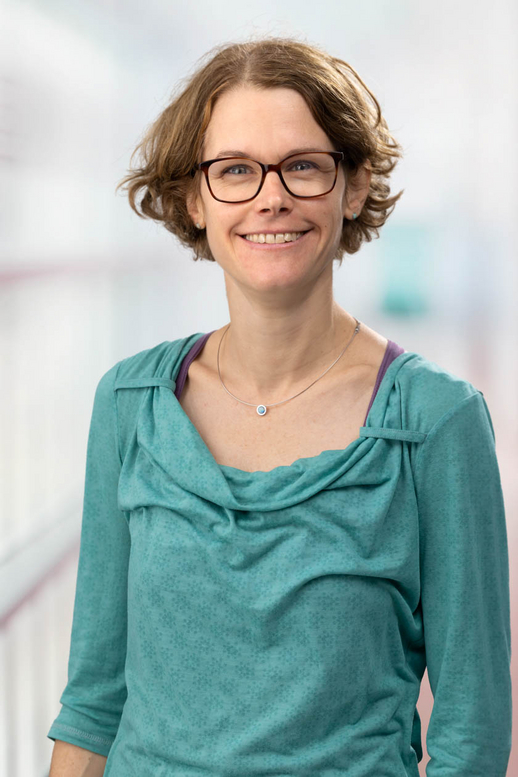

Prof. Dr. Claudine Kraft

Contact
University of Freiburg
T +49 761 203 5221
claudine.kraft(at)biochemie.uni-freiburg.de
Further Information
Our group aims at understanding how the molecular machinery of autophagy, the cellular waste disposal system, works.
The major focus of our work lays on dissecting the molecular mechanisms in autophagy. The field of autophagy is still very young, as it only emerged in the last two decades. Many basic questions remain unanswered, such as how autophagosomes form and where the autophagic membranes come from. We believe in hypothesis driven basic research to study how cells function. Our vision is to first study the basic molecular mechanisms in a simple setup, to then understand how a pathway acts in more complex situations, such as multicellular organisms or diseases.
10 selected publications:
- Phase separation of initiation hubs on cargo is a trigger switch for selective autophagy. Licheva M*, Pflaum J*, Babic R*, Mancilla M*, Elsässer J, Boyle E, Hollenstein D, Jimenez J, Pleyer J, Heinrich M, Wieland FG, Brenneisen J, Eickhorst C, Brenner J, Jiang S, Hartl M, Welsch S, Hunte C, Timmer J, Wilfling F*, and Kraft C* (2025). Nature Cell Biology. DOI: 10.1038/s41556-024-01572-y
- FIP200 phosphorylation regulates late steps in mitophagy. Eickhorst C*, Babic R*, Rush-Kittle J, Lucya L, Imam FL, Sanchez-Martin P, Hollenstein D, Michaelis J, Münch C, Meisinger C, Slade D, Gamez-Diaz L*, and Kraft C* (2024). Journal of Molecular Biology. DOI: 10.1016/j.jmb.2024.168631
- Decoding the function of Atg13 phosphorylation reveals a role of Atg11 in bulk autophagy initiation. Bhattacharya A, Raffaela Torggler R, Reiter W, Romanov N, Licheva M, Ciftci A, Mari M, Kolb L, Kaiser D, Reggiori F, Ammerer G, Hollenstein D*, and Kraft C* (2024). EMBO Rep. DOI : 10.1038/s44319-023-00055-9
- ULK1-mediated phosphorylation regulates the conserved role of YKT6 in autophagosome-lysosome fusion. Sanchez-Martin P*, Kriegenburg F*, Alves L, Adam J, Elsaesser J, Babic R, Mancilla H, Licheva M, Tascher G, Münch C, Eimer S, and Kraft C (2023). Journal of Cell Science. DOI: 10.1242/jcs.260546
- Hollenstein D*, Licheva M*, Konradi N, Schweida D, Mancilla H, Mari M, Reggiori F, and Kraft C (2021). Spatial control of avidity regulates initiation and progression of selective autophagy. Nature Communications. DOI: 10.1038/s41467-021-27420-3
- Atg1 kinase regulates autophagosome-vacuole fusion by controlling SNARE bundling. Barz S*, Kriegenburg F*, Henning A, Bhattacharya A, Mancilla H, Sánchez-Martín P, and Kraft C (2020). EMBO Reports. DOI: 10.15252/embr.202051869
- Vac8 establishes an autophagosome formation site between the vacuole and the ER. Hollenstein D, Gómez‐Sánchez R, Ciftci A, Kriegenburg F, Mari M, Torggler R, Licheva M, Reggiori F, and Kraft C (2019). Journal of Cell Science DOI: 10.1242/jcs.235002
- Reconstitution reveals Ykt6 as the autophagosomal SNARE in autophagosome-vacuole fusion. Bas L, Papinski D, Licheva M, Torggler R, Rohringer S, Schuschnig M, and Kraft C (2018). Journal of Cell Biology. DOI: 10.1083/jcb.201804028
- Two Independent Pathways within Selective Autophagy Converge to Activate Atg1 Kinase at the Vacuole. Torggler R*, Papinski D*, Brach T*, Bas L, Schuschnig M, Pfaffenwimmer T, Rohringer S, Matzhold T, Schweida D, Brezovich A and Kraft C (2016). Molecular Cell. DOI: 10.1016/j.molcel.2016.09.008
- Early steps in autophagy depend on direct phosphorylation of Atg9 by the Atg1 kinase. Papinski D, Schuschnig M, Reiter W, Wilhelm L, Barnes C, Majolica A, Hansmann I, Pfaffenwimmer T, Kijanska M, Stoffel I, Lee SS, Brezovich A, Lou HJ, Turk BE, Aebersold R, Ammerer G, Peter M and Kraft C (2014). Molecular Cell. DOI: 10.1016/j.molcel.2013.12.011



